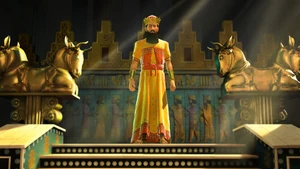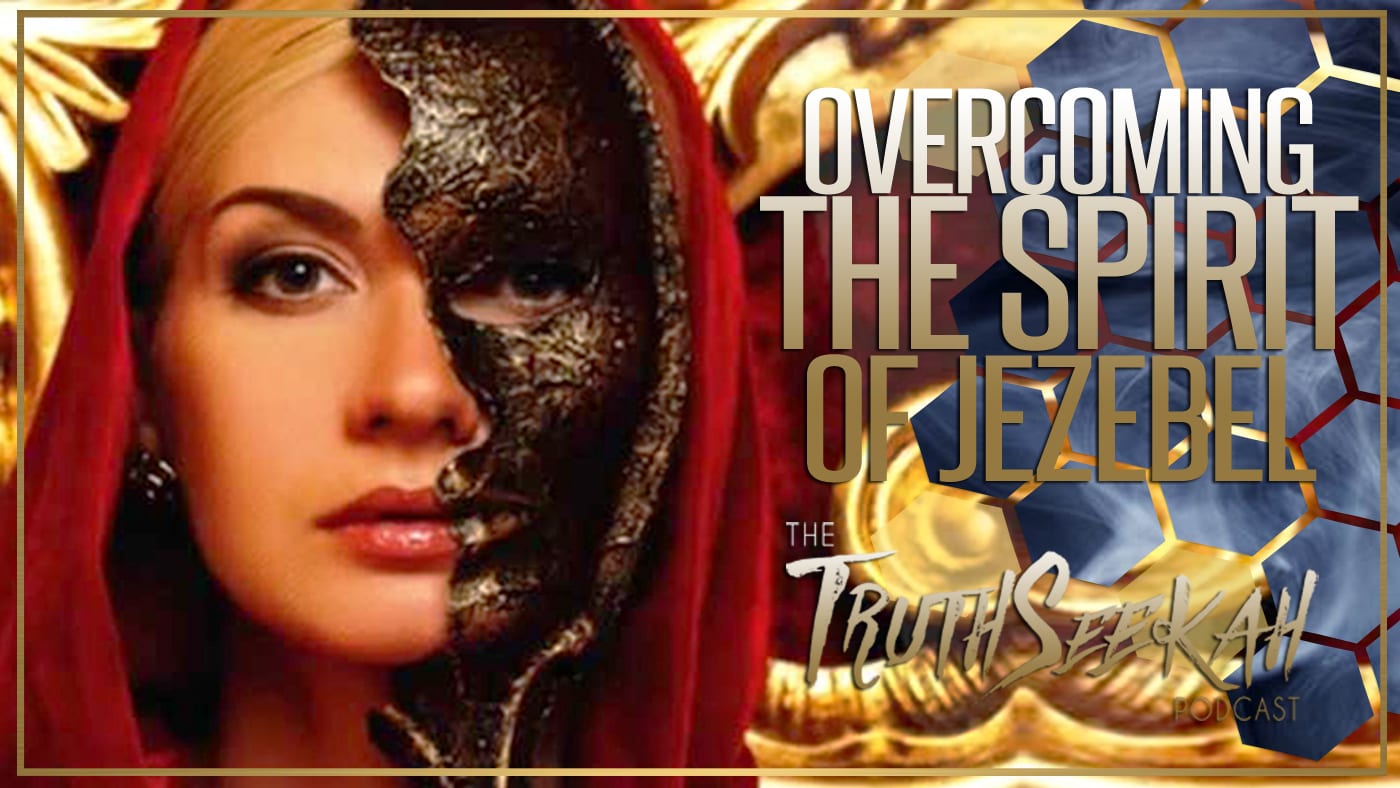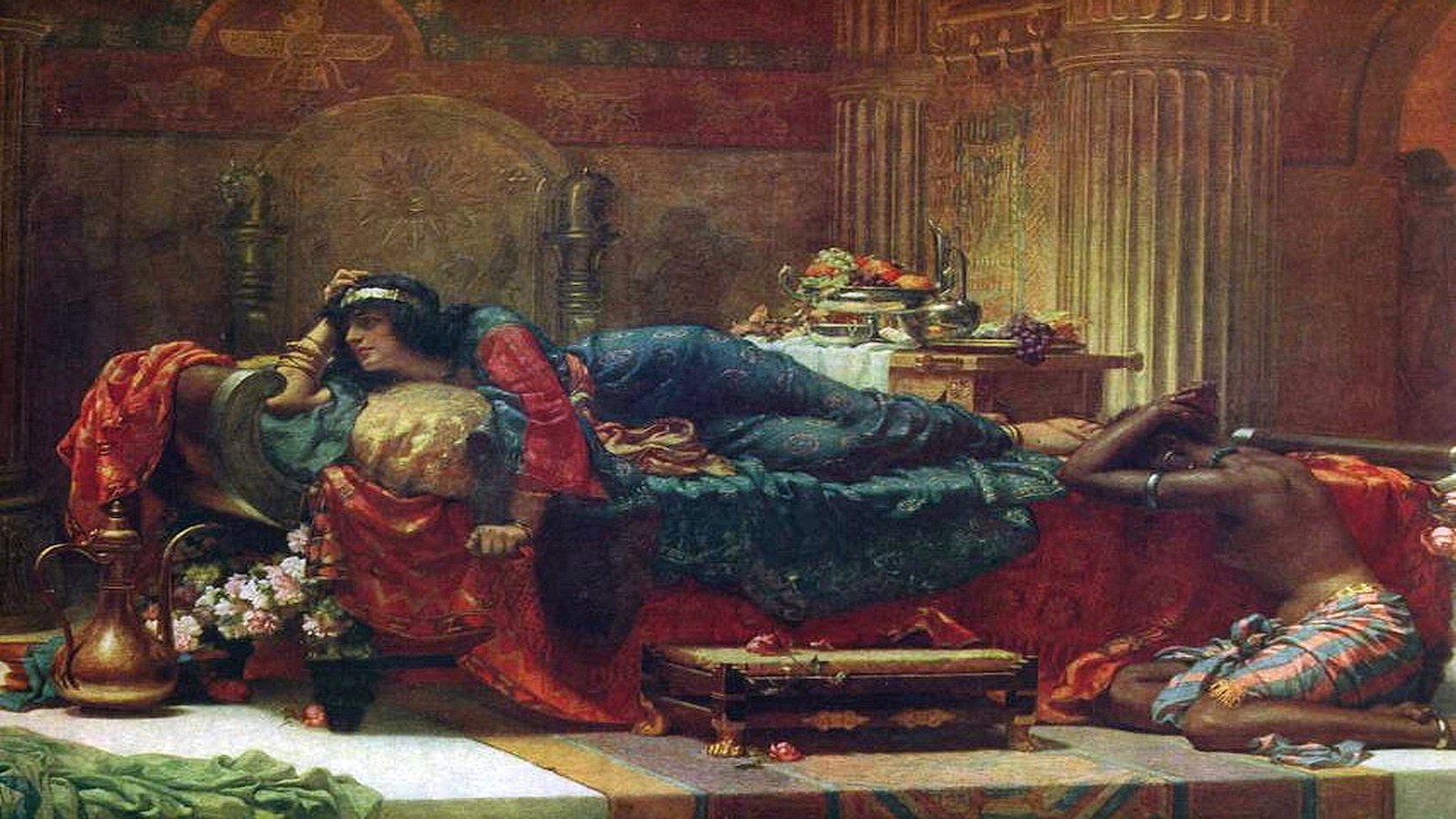“[Esther]
is fully visible, unlike Jezebel, but her intentions are concealed from the
beholder. Esther is also beautiful, a familiar attribute of matriarchs in the [Hebrew
Bible]. ….
Jezebel
lacks a face and a figure, as though she is made of an evil spirit alone”.
Helena Zlotnick
Helena ZLOTNICK
|
Biblica 82 (2001) 477-495
|
From Jezebel
to Esther:
Fashioning Images of Queenship in the Hebrew Bible
…. At the heart of this study stands the
hypothesis that the story of Esther and Ahasuerus must be read as a
rehabilitative narrative of the tale of Jezebel and Ahab. To be exact, the
narrative of Esther, if read sensibly and sensitively, bears unmistakable
allusions to that of Jezebel. Both share an ideological kinship that aspires to
define the desired characteristics and behavior of Israelite/Jewish queens.
An investigation into the use of Jezebel as a
shadowy foil to Esther highlights biblical (redactional) ideas regarding
queenly images, queenly spheres of influence and the molding of
‘Israelite’/Jewish queens ….
I. The Royal Wife:
Queens as Protagonists
Jezebel is remembered, above all, for her role in
the famed episode of the vineyard of Naboth (1 Kgs 21) …. The story begins with
direct negotiations between two men, a king and his subject, Ahab and Naboth,
over the legal acquisition of a plot of land adjacent to a royal residence. The
exchange is terminated with Naboth’s insistence on the inalienable character of
his property. His refusal to comply with the king’s desire leaves Ahab with two
options: he can abandon his rosy visions of a palatial garden (21,2) or he can
exert his authority to prevail, by hook and by crook, over the scruples and the
objections of Naboth. The king chooses neither. Returning home from his
unprofitable dialogue with Naboth he retires to his bedchamber in a foul mood
and plunges into a fast ….
As the scene shifts from the outside with its
vineyards and hypothetical gardens to the royal bedroom the queen enters the
picture. Her ‘credentials’ had already been established. Readers had been
familiarized with this Sidonian princess as the moving spirit behind her
husband’s devotion to the Baal (16,31), and as the mortal enemy of YHWH’s
prophets (18,4.13)…. The fact that Ahab’s marriage with her also signaled the
acceptance of the Omrides by their neighbors was deemed irrelevant by the
biblical redactor. Yet, with the exception of Solomon, only Ahab achieved the
kind of ‘international’ status that made him a desirable match in the eyes of
neighboring kings.
Jezebel’s intrusion into Ahab’s self-imposed
solitude re-enacts the tale of the vineyard verbally and in the intimacy of the
royal bedroom. Within this familial context Jezebel emerges as the king’s
solicitous spouse rather than as a bearer of idolatry. Her question, ‘What is
the matter with you and why are you not eating’ (1 Kgs 21,5), supports this
image. Ahab replies with a distorted version of the words exchanged with
Naboth. According to his presentation Naboth was guilty of obstinacy if not of
disobedience through an unreasonable refusal of complying with the king’s
seemingly reasonable request.
On the surface, this brief and rare glimpse into
a royal marriage reveals a model of spousal relations and an inordinate degree
of marital harmony and trust …. Ahab admits his weakness to a sympathetic wife
expecting, presumably, support and understanding. She expresses perhaps
indignation perhaps surprise and promises the fulfillment of his desires. He
refrains from probing her promise. Even before this bedroom snapshot the text
refers to the couple’s closeness and her status, in spite of Ahab’s other
wives. He shares with her not only her gods but also information about the
management of the kingdom, including the difficulties attendant on the
maintenance of correct relations with YHWH’s prophet, Elijah (1 Kgs 19,1). She
issues a death threat to Elijah that effectively undermines Ahab’s conciliatory
politics and demonstrates her standing at the court.
How extraordinary was the association of an
‘Israelite’ queen, even of foreign descent, with unlimited accessibility to the
king can be fully appreciated through the fashioning of royal intimacy in the
scroll of Esther …. Only three royal couples in the … [Hebrew Bible], Jezebel
and Ahab, Esther and Ahasuerus, David and Bathsheba, are seen, or rather heard
in direct verbal communication. But the nature of Bathsheba’s intercession is
dictated by motherly and not by wifely concerns. Her appearance in the king’s
bedroom, where another woman had been occupying the king’s bed, is carefully
orchestrated by a prophet. She is neither Jezebel nor Esther.
Like Jezebel, Esther is one of many royal
consorts. Unlike Jezebel, when Esther approaches her royal husband she is not
only afraid of the consequences of appearing without summons but she also
behaves as a humble petitioner rather than a royal consort (Esth 4,11). Even in
the privacy of her own rooms Esther has to tread carefully. After obtaining
permission to stage a private banquet for the king and a favorite minister
(Haman) she dares not bring up her grievance before plying Ahasuerus with
drinks (Esth 7,1.2.7). And even then she waits till Ahasuerus seeks
enlightenment regarding the identity of the author of the anti-Jewish measures in
his kingdom.
When Esther exposes Haman Ahasuerus, like Ahab,
retires in anger not to his bedroom but rather to an adjacent garden. That the
scroll conjures up for the king’s inflamed spirit the exact same soothing
landscape that Ahab had desired to create out of Naboth’s vineyard seems hardly
a coincidence. Ahasuerus’ brief stroll in the queen’s garden is staged as a
prelude to the climax of the plot and marks the end of Haman’s career. Ahab’s
urge to enlarge the palace’s garden sets in motion a series of crimes and
signals the demise of his dynasty.
Both the Dtr historian (= the redactor of 1 Kgs
21) and the author of the scroll cloth with mockery the marriages they
delineate. The former casts the king’s bedroom as a launching pad for queenly
crimes; the latter places the queen in bed with her enemy rather than with her
lawful consort. In both narratives communications between king and queen,
although direct, are marked by evasions and half-truths. Ahab and Jezebel
communicate through deceptions. He provides an edited version of his dealings
with Naboth while she avoids further delving into both his statements and her
own strategies. Esther hides her true identity from Ahasuerus when she joins
the harem. She also conceals her true intention from him when she solicits
permission to hold a private banquet for Haman. If Ahasuerus believed his
beautiful wife, a rather doubtful proposition, he elected to humor her by
pretending ignorance.
An interplay between the words and the actions
of the protagonists further reveals parallels between the tales of Jezebel and
Esther. Jezebel reminds Ahab of his royal status only to undermine her own
assertion by assuming kingly power. Mordechai, ostensibly a caring relative,
reminds Esther of her position at the court solely to prompt her to use it in
spite of danger to her life in obeying his order. Neither Ahab nor Esther, of
course, requires the admonition. But the reminders also imply an admission of
Mordechai’s own helplessness and of Ahab’s inability to deal with the
situation. As the action shifts into the hands of the two queens the scroll is
still careful to entrust the initial urging into the hands of a male relative,
thereby ‘correcting’ the Dtr history that had cast Jezebel as the prompter and
the actor.
A choice of seminal gestures and phrases in the
scroll’s description of critical preliminaries appears to recall, somewhat
perversely but accurately, the earlier narrative. When Esther hears that
Mordechai has been seen donning mourning clothes at the gate of the palace she
orders an inquiry into this seemingly inexplicable and apparently inexcusable
public display (Esth 4,1-5). Jezebel addresses her grief-stricken and fasting
spouse in a similar mode, likewise implying that his behavior is uncalled for.
At the heart of the familial encounters on the eve of a crisis are two
difficult phrases that emphasize the addressee’s status. ‘Who knows? Perhaps
you have attained royalty for just such a time as this?’ (Esth 4,14) …. Jezebel
addresses Ahab with a similarly pregnant question: ‘Do you now govern Israel?’
(1 Kgs 21,7). In both instances a rhetoric of timeliness is intended to spur
the protagonists to action. Mordechai succeeds in coercing Esther to act;
Jezebel becomes an actor rather than a prompter.
Structurally, the later narrative also encodes
the making of Esther as a queen in a sequence that echoes Jezebel’s queenly
progress. In the wake of the fateful exchange between Esther and Mordechai
Esther, like Jezebel after her interchange with Ahab, appropriates control over
the course of events. She issues an order to summon the Jews of Susa for a
three-day fast (Esth 4,16). In the reconstructed order of events in 1 Kgs 21
Jezebel acts along precisely the same lines: she summons the council of the
elders in Naboth’s town and calls for a fast (21,9). In both cases the queen
effectively transfers the gestures (fasting; mourning) that launch fatal
encounters between kin (Ahab/Jezebel; Mordechai/Esther) to a wider circle of
the public, thereby opening the door to an outbreak or a resolution of a
crisis.
Lest, however, these close analogies inspire
unwary readers with either sympathy towards Jezebel or hostility to Esther, the
latter narrator carefully parts the ways of the two queens. Jezebel disappears,
physically, from subsequent proceedings. Her invisible presence, however, is
constantly referred to in the text. By contrast, Esther appears in all her
regal splendor in the inner palace court as she implements the first part of
her plan to save the Jews from extinction. She is fully visible, unlike
Jezebel, but her intentions are concealed from the beholder.
Esther is also beautiful, a familiar attribute
of matriarchs in the … [Hebrew Bible]. Jezebel lacks a face and a figure, as
though she is made of an evil spirit alone. Moreover, readers are aware of
Jezebel’s aim from the start as she sets out to fulfil her husband’s wish. Her
method of achieving it soon becomes apparent. In the scroll neither husband nor
its readers are familiarized with Esther’s schemes to deliver her promise.
….
Esther is not only Jewish but a woman with
impeccable royal (Jewish) blood in her veins. Jezebel is constantly branded a
foreigner in a manner that reflects not only her ethnicity but also her
proclivities…. In the redactional history of the Hebrew Bible the Deuteronomist
antipathy to foreigners, and particularly to foreign queens, has been
associated with a deep-seated fear of idolatry through contamination. ….
….
The scroll depicts the decree of Ahasuerus-Haman
ordering the elimination of the Jews as a writ of national emergency. The clash
between Ahab and Naboth appears, at first, as carrying little import beyond the
king’s petty desire to expand to plant vegetables. Yet behind the issue of the
vineyard versus royal garden lurks the larger question of the legitimate scope
of monarchical actions vis-à-vis the king’s subjects. ….
….
Underlying Jezebel’s assumption of royal
authority in the case of Naboth is the pitting of her patron-god, the Baal,
with the national Israelite divinity, YHWH. Within this context the queen’s
uncompromising loyalty to her husband, in itself a commendable wifely trait, is
completely obscured. Esther is not even expected to display spousal loyalty to
her royal husband but rather a commitment to her own community of origin. Her
dilemma as a wife and a queen is staged as a predicament of the Jewish people
as a whole. Ahab’s reflects the king’s own pettiness.
In the name of Ahab Jezebel communicates the king’s
alleged commands to the local authorities in Naboth’s hometown. The redacted
story does not explain whether she had been empowered to do so. It implies that
she abused, rather than used the king’s implicit trust in her. …. In the scroll
of Esther not a single person, wife or otherwise, is allowed to issue royal
commands without the king’s explicit seal of approval. Jezebel acts on her own
initiative and without the prompting of a male relative. In her eyes she is
embarking on a just vindication of the injured royal dignity.
The theme of writing on behalf of the king, with
or without explicit permission, and of using the royal seal to convey the legality
of the message dominates both the Jezebel and the Esther accounts. …. 1 Kgs
21,8 depicts Jezebel as writing a royal letter to Naboth’s peers by herself but
in Ahab’s name, and using his seal. She is thus engaged in a pursuit that is
not only unacceptable when undertaken by men without duly conferred authority
but is the height of impropriety when practiced by a woman. Yet, according to 1
Kgs 21,9 the letter merely contained a call for a local fast although the
redacted sequence of the events strongly suggests that it also contained
instructions regarding the staging of the whole affair.
Esther’s sojourn at the court is marked from the
very start by directions incorporated in written commands. She is joined to the
harem upon the publication and dissemination of a royal order to gather
beauties from all over the kingdom (Esth 2,8). Ahasuerus endorses Haman’s
request to eliminate the Jews with his own seal (= ring) (Esth 3,10) and the
royal scribes articulate the command in a series of letters that they
distribute (Esth 3,12-13). The fact that such orders had been issued in the
name of the king and not of his minister is tacitly ignored by Esther when she
pleads in front of Ahasuerus (Esth 7,4-6). The king’s implicit or explicit
permission is precisely the aspect that the redactor of the Naboth affair never
lets the readers forget when he insists on the concealed authorship of Jezebel.
Finally, to illustrate the changing fortunes of Haman, Ahasuerus allows Esther
and Mordechai to issue in his name and with his seal commands relating to the
fate of their enemies (Esth 8,8). According to the scroll’s redactor, such
royal orders, albeit not a royal initiative, nevertheless possess full legal
validity and are irreversible (Esth 8,8).
….
Casting Jezebel as a usurper of the king’s
authority through stealth reflects both the real limits of queenly power and
the redactor’s own biases. To rehabilitate this queenly image the scroll
carefully invests Esther with direct royal authority to issue empire-wide
commands in the king’s name.
Without, evidently, Ahab’s knowledge or
permission Jezebel bids the leading men in Naboth’s town to announce a public
fast and to appoint Naboth to head this solemn occasion. No reason is given to
account for the fast, nor is objection offered. …. Perhaps the drought that had
marked Ahab’s reign provided the pretext. Unlike Naboth, his peers obey the
royal desire without demure or protest. …. The fast, as in other biblical
narratives, serves as a preliminary to a critical public occasion. In Neh 9,1 a
fast precedes the ceremony of the renewal of the ancient covenant between YHWH
and the exilic community in Yehud. In 1 Kgs 21 the fast is concluded with a
judicial murder that signals the demise of the Omride dynasty. Throughout
Persia the news of the decree ordering the execution of the Jews prompts a
general fast (Esth 4,4). Like Jezebel, Esther calls for a fast as she prepares
herself for what can become a fatal encounter with the king (Esth 4,16). ….




